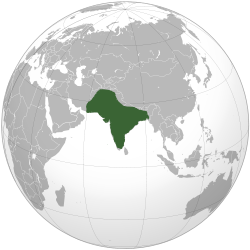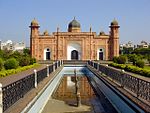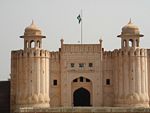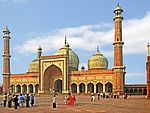
Mughal Empire
Background to the schools Wikipedia
This selection is made for schools by a children's charity read more. Child sponsorship helps children one by one http://www.sponsor-a-child.org.uk/.
| Mughal Empire گورکانیان ( fa) مغلیہ سلطنت (ur) |
||||||||||||||||||||||||||||||||||||
|
||||||||||||||||||||||||||||||||||||
|
Flag |
||||||||||||||||||||||||||||||||||||
|
The Mughal Empire during the reign of Aurangzeb c. 1700
|
||||||||||||||||||||||||||||||||||||
| Capital | Agra (1526–1571) Fatehpur Sikri (1571–1585) Lahore (1585–1598) Agra (1598–1648) Shahjahanabad (1648–1857) |
|||||||||||||||||||||||||||||||||||
| Languages | Persian (official and court language) Chagatai Turkic (only initially) Urdu (later on) |
|||||||||||||||||||||||||||||||||||
| Religion | Islam (1526–1582) Din-e Ilahi (1582–1605) Islam (1605–1857) |
|||||||||||||||||||||||||||||||||||
| Government | Absolute monarchy, unitary state with federal structure |
|||||||||||||||||||||||||||||||||||
| Emperor | ||||||||||||||||||||||||||||||||||||
| - | 1526–1530 | Babur Beg (first) | ||||||||||||||||||||||||||||||||||
| - | 1837–1857 | Bahadur Shah II (last) | ||||||||||||||||||||||||||||||||||
| Historical era | Early modern | |||||||||||||||||||||||||||||||||||
| - | Battle of Panipat | 21 April 1526 | ||||||||||||||||||||||||||||||||||
| - | Indian Rebellion | 10 May 1857 | ||||||||||||||||||||||||||||||||||
| Area | ||||||||||||||||||||||||||||||||||||
| - | 1700 | 4,500,000 km² (1,737,460 sq mi) | ||||||||||||||||||||||||||||||||||
| Population | ||||||||||||||||||||||||||||||||||||
| - | 1700 est. | 150,000,000 | ||||||||||||||||||||||||||||||||||
| Density | 33.3 /km² (86.3 /sq mi) | |||||||||||||||||||||||||||||||||||
| Currency | Rupee | |||||||||||||||||||||||||||||||||||
|
||||||||||||||||||||||||||||||||||||
| Today part of | ||||||||||||||||||||||||||||||||||||
|
||||||||||||||||||||||||||||||||||||
The Mughal Empire ( Persian: امپراتوری مغولی هند, Imperatory-e Moghuly-e Hind, self-designation: گورکانیان, Gurkanian; Urdu: مغلیہ سلطنت, Moghly-e Soltanat), or Mogul (also Moghul) Empire in traditional English usage, was an imperial power in the Indian subcontinent from about 1526 to 1757 (though it lingered for another century). The Mughal emperors were Muslims and direct descendants of Genghis Khan through Chagatai Khan and Timur. At the height of their power in the late 17th and early 18th centuries, they controlled most of the subcontinent—extending from Bengal in the east to Balochistan in the west, Kashmir in the north to the Kaveri basin in the south. Its population at that time has been estimated as between 110 and 150 million, over a territory of more than 3.2 million square kilometres (1.2 million square miles).
The "classic period" of the empire started in 1556 with the accession of Akbar the Great. Under his rule, India enjoyed much cultural and economic progress as well as religious harmony. Akbar was a successful warrior; he also forged martial alliances with several Hindu Rajput kingdoms. Some Rajput kingdoms continued to pose a significant threat to Mughal dominance of northwestern India, but they were subdued by Akbar.
The reign of Shah Jahan, the fifth emperor, was the golden age of Mughal architecture and the arts. He erected many splendid monuments, the most famous of which is the legendary Taj Mahal at Agra, as well as the Pearl Mosque, the Red Fort, the Jama Masjid of Delhi, and the Lahore Fort. The Mughal Empire reached the zenith of its territorial expansion during the reign of Aurangzeb. During his lifetime, victories in the south expanded the Mughal Empire to more than 1.25 million square miles, ruling over more than 150 million subjects, nearly 1/4th of the world's population, with a combined GDP of over $90 billion.
By the mid-18th century, the Marathas had ravaged the Mughal provinces from the Deccan to Bengal, and internal dissatisfaction (as well as separatist agendas from the Rajputs, Sikhs, and Jats) arose due to the weakness of the Mughal Empire's administrative and economic systems. In 1739, a weakened Mughal Empire was defeated in the Battle of Karnal by the forces of Nader Shah. Mughal power was severely limited. The last emperor, Bahadur Shah II had authority over only the city of Shahjahanabad. He supported the Indian Rebellion of 1857 and was overthrown by the British, and the last remnants of the empire were taken over by the British Raj.
Early history

The name Mughal is derived from the original homelands of the Timurids, the Central Asian steppes once conquered by Genghis Khan and hence known as Moghulistan, "Land of Mongols". Although early Mughals spoke the Chagatai language and maintained some Turko-Mongol practices, they became essentially Persianized and transferred the Persian literary and high culture to India, thus forming the base for the Indo-Persian culture and the Spread of Islam in South Asia.
Zahir ud-din Muhammad Babur acquired Kabulistan in 1504, and decided to regain the territories in Hindustan held once by Turks. He started his exploratory raids from September 1519 when he visited the Indo-Afghan borders to suppress the rising by Yusufzai tribes. He undertook similar raids up to 1524 and had established his base camp at Peshawar. Finally in 1526 in his fifth attempt, Babur defeated the last of the Delhi Sultans, Ibrahim Shah Lodi, at the First Battle of Panipat. To secure his newly founded kingdom, Babur then had to face the formidable Indian king Rana Sanga of Chittor, at the Battle of Khanwa. Rana Sanga offered stiff resistance but was defeated.
Babur's son Humayun succeeded him in 1530, but suffered reversals at the hands of the Pashtun Sher Shah Suri and lost most of the fledgling empire before it could grow beyond a minor regional state. Humayun crossed the rough terrain of the Makran with his wife until their son Akbar was born in the fortress of Umarkot in Sind. From 1540, Humayun became ruler in exile, reaching the court of the Safavid rule in 1554 while his force still controlled some fortresses and small regions. During 1553–1556, the Hindu king, Hemu Vikramaditya acceded to the throne of Delhi by defeating forces of the Mughal Emperor Akbar at Agra and Delhi. After the battle of Sirhind in which Sikandar Sur was defeated, Humayun was able to recapture his throne, but wasn't able to rule it for long, as in January, 1556, he died by slipping from the famous building known as Din Panah. However, the Mughals reestablished their rule after Akbar's army defeated Hemu during the Second Battle of Panipat.
Akbar succeeded his father on 14 February 1556. He became known as Akbar, as he was a wise ruler, setting high but fair taxes. He was more inclusive in his approach to the non-Muslim subjects of the Empire. He investigated the production in a certain area and taxed inhabitants one-fifth of their agricultural produce. He also set up an efficient bureaucracy and was tolerant of religious differences which softened the resistance by the locals. He made alliances with Rajputs and appointed native generals and administrators. Later in life, he devised his own brand of syncretic philosophy based on tolerance.
Jahangir, son of Emperor Akbar, ruled the empire from 1605–1627. In October 1627, Shah Jahan, son of Emperor Jahangir succeeded to the throne, where he inherited a vast and rich empire. At mid-century this was perhaps the greatest empire in the world. Shah Jahan commissioned the famous Taj Mahal (1630–1653) in Agra which was built by the Persian architect Ustad Ahmad Lahauri as a tomb for Shah Jahan's wife Mumtaz Mahal, who died giving birth to their 14th child. By the late 17th century, the empire reached its peak under the leadership of Aurangzeb Alamgir when it included almost all of present day India, Pakistan, Bangladesh and most of Afghanistan, and parts of what are today Tajikistan and Nepal.
Mughal dynasty

The Mughal Empire was the dominant power in the Indian subcontinent between the mid-16th century and the early 18th century. Founded in 1526, it officially survived until 1858, when it was supplanted by the British Raj. The dynasty is sometimes referred to as the Timurid dynasty as Babur was descended from Timur.
The Mughal dynasty was founded when Babur, hailing from Ferghana (Modern Uzbekistan), invaded parts of northern India and defeated Ibrahim Shah Lodhi, the ruler of Delhi, at the First Battle of Panipat in 1526. The Mughal Empire superseded the Delhi Sultanate as rulers of northern India. In time, the state thus founded by Babur far exceeded the bounds of the Delhi Sultanate, eventually encompassing a major portion of India and earning the appellation of Empire. A brief interregnum (1540–1555) during the reign of Babur's son, Humayun, saw the rise of the Afghan Suri Dynasty under Sher Shah Suri, a competent and efficient ruler in his own right. However, Sher Shah's untimely death and the military incompetence of his successors enabled Humayun to regain his throne in 1555. However, Humayun died a few months later, and was succeeded by his son, the 13-year-old Akbar the Great.
The greatest part of the Mughal expansion was accomplished during the reign of Akbar (1556–1605). The empire was maintained as the dominant force of the present-day Indian subcontinent for a hundred years further by his successors Jahangir, Shah Jahan, and Aurangzeb. The first six emperors, who enjoyed power both de jure and de facto, are usually referred to by just one name, a title adopted upon his accession by each emperor. The relevant title is bolded in the list below.
Akbar the Great initiated certain important policies, such as religious liberalism (abolition of the jizya tax), inclusion of natives in the affairs of the empire, and political alliance/marriage with the Indian rulers of north India, that were innovative for his milieu; he also adopted some policies of Sher Shah Suri, such as the division of the empire into sarkar raj, in his administration of the empire. These policies, which undoubtedly served to maintain the power and stability of the empire, were preserved by his two immediate successors but were discarded by Emperor Aurangzeb who spent nearly his entire career expanding his realm, beyond the Urdu Belt, into the Deccan and South India, as well as into Assam in the east; this venture provoked resistance from the Marathas, Sikhs, Jats and Ahoms.
Decline
Mughal architecture
The main outside force contributing to the destruction of the Mughal Empire was the Hindu Maratha Empire. Chatrapati Shivaji declared "Hindu Swarajya" (Independence for Hindus) and raised an army that could outfight the larger Mughal armies. Santaji Ghorpade and Dhanaji Jadhav, one by one, eliminated most of the Mughal generals. Mountstart Elphinstone call this period a demolishing period for "Mussalmans" with many of them losing spirit to fight against the Maratha army. Aurangzeb lead Mughals in the war of 27 years with Marathas in which Mughal suffered defeat with heavy losses. In 1706, just a few months before Aurangzeb's death, his son Prince Bakht was routed by Maratha General Dhanaji in South Gujarat. Defeats of the imperial army brought disgrace to the throne, and its helplessness was apparent after Aurangzeb's death. Maratha Prime Minister Peshwa made deep inroads ravaging Mughal outposts in much of the Indian Subcontinent in the subsequent years. After Aurangzeb's death, Shivaji's grandson Shahu was released by the Mughals, which brought some peace between the Marathas and Mughals. However, the Marathas continued to expand their Empire. Peshwa Vishwanath Balaji Rao ravaged Mughal Deccan territory and forced the Mughal emperor to make "Chatrapati Shahu" the viceroy of Deccan. It was, however,Vishwanath's son Baji Rao I who is credited with overthrowing Mughal control from Deccan to the Punjab and from Bengal to Sindh; Sir Jadunath Sarka calls him the "Second Shivaji". Assuming the post of Peshwa at 19 years age, he started invading northern Mughal strongholds. In 1728, he defeated Nizam in the Battle of Palkhed, and in 1729, defeated Muhammad Khan Bangash at Bundelakhand. None of the Muslim generals were able to stop him, and by 1735, he had annexed Rajasthan and Bundelkhand. In 1737, he invaded and plundered Delhi itself. Under Amir Khan Umrao Al Udat, he sent 8,000 troops to drive away the 5,000 Maratha cavalry soldiers. Baji Rao, however, easily routed the novice Mughal general and the rest of the imperial Mughal army fled. In 1737, in the final defeat of Mughal Empire, the commander-in-chief of the Mughal Army, Nizam-ul-mulk, was routed at Bhopal by the Maratha army. This essentially brought an end to the Mughal Empire. The final blow came from Nadir Shah in 1739.
For the next century the Mughal emperors had authority only over Delhi. In 1857, Emperor Bahadur Shah II—a mystic who led a renaissance in poetry—supported the Indian Rebellion of 1857. He was overthrown by the British, his sons killed, and the last remnant of the Mughal empire was absorbed into the British Raj.
Historiography
Historians have offered numerous explanations for the rapid collapse of the Mughal Empire between 1690 and 1720, after a century of growth and prosperity. In fiscal terms the throne lost the revenues needed to pay its chief officers, the emirs (nobles) and their entourages. The emperor lost authority, as the widely scattered imperial officers lost confidence in the central authorities, and made their own deals with local men of influence. The imperial army, bogged down in long, futile wars against the more aggressive Marathas, lost its fighting spirit. Finally came a series of violent political feuds over control of the throne. After the execution of emperor Farrukhsiyar in 1719, local Mughal successor states took power in region after region.
Contemporary chroniclers bewailed the decay they witnessed, a theme picked up by the first British historians who wanted to underscore the need for a British-led rejuvenation.
Since the 1970s historians have taken multiple approaches to the decline, with little consensus on which factor was dominant. The psychological interpretations emphasize depravity in high places, excessive luxury, and increasingly narrow views that left the rulers unprepared for an external challenge. A Marxist school (led by Irfan Habib and based at Aligarh Muslim University) emphasizes excessive exploitation of the peasantry by the rich, which stripped away the will and the means to support the regime. Karen Leonard has focused on the failure of the regime to work with Hindu bankers, whose financial support was increasingly needed; the bankers then helped the Maratha and the British. In a religious interpretation, some scholars argue that the Hindu Rajputs revolted against Muslim rule. Finally other scholars argue that the very prosperity of the Empire inspired the provinces to achieve a high degree of independence, thus weakening the imperial court.
List of Mughal emperors
| Emperor | Birth | Reign Period | Death | Notes |
|---|---|---|---|---|
| Babur | Feb 23, 1483 | 1526–1530 | Dec 26, 1530 | Was a direct descendant of Genghis Khan through Timur and was the founder of the Mughal Empire after his victories at the Battle of Panipat (1526) ad the Battle of Khanwa. |
| Humayun | Mar 6, 1508 | 1530–1540 | Jan 1556 | Reign interrupted by Suri Dynasty. Youth and inexperience at ascension led to his being regarded as a less effective ruler than usurper, Sher Shah Suri. |
| Sher Shah Suri | 1472 | 1540–1545 | May 1545 | Deposed Humayun and led the Suri Dynasty. |
| Islam Shah Suri | c.1500 | 1545–1554 | 1554 | 2nd and last ruler of the Suri Dynasty, claims of sons Sikandar and Adil Shah were eliminated by Humayun's restoration. |
| Humayun | Mar 6, 1508 | 1555–1556 | Jan 1556 | Restored rule was more unified and effective than initial reign of 1530–1540; left unified empire for his son, Akbar. |
| Akbar | Nov 14, 1542 | 1556–1605 | Oct 27, 1605 | He and Bairam Khan defeat Hemu during the Second Battle of Panipat and later won famous victories during the Siege of Chittorgarh and the Siege of Ranthambore; He greatly expanded the Empire and is regarded as the most illustrious ruler of the Mughal Empire as he set up the empire's various institutions; he married Mariam-uz-Zamani, a Rajput princess. One of his most famous construction marvels was the Lahore Fort. |
| Jahangir | Oct 1569 | 1605–1627 | 1627 | Jahangir set the precedent for sons rebelling against their emperor fathers. Opened first relations with the British East India Company. Reportedly was an alcoholic, and his wife Empress Noor Jahan became the real power behind the throne and competently ruled in his place. |
| Shah Jahan | Jan 5, 1592 | 1627–1658 | 1666 | Under him, Mughal art and architecture reached their zenith; constructed the Taj Mahal, Jama Masjid, Red Fort, Jahangir mausoleum, and Shalimar Gardens in Lahore. Deposed by his son Aurangzeb. |
| Aurangzeb | Oct 21, 1618 | 1658–1707 | Mar 3, 1707 | He reinterpreted Islamic law and presented the Fatawa-e-Alamgiri; he captured the diamond mines of the Sultanate of Golconda; he spent the major part of his last 27 years in the war with the Maratha rebels; at its zenith, his conquests expanded the empire to its greatest extent; the over-stretched empire was controlled by Mansabdars, and faced challenges after his death. He is known to have transcribed copies of the Qur'an using his own styles of calligraphy. he died during a campaign against the ravaging Marathas in the Deccan. |
| Bahadur Shah I | Oct 14, 1643 | 1707–1712 | Feb 1712 | First of the Mughal emperors to preside over an empire ravaged by uncontrollable revolts. After his reign, the empire went into steady decline due to the lack of leadership qualities among his immediate successors. |
| Jahandar Shah | 1664 | 1712–1713 | Feb 1713 | Was an unpopular incompetent titular figurehead; |
| Furrukhsiyar | 1683 | 1713–1719 | 1719 | His reign marked the ascendancy of the manipulative Syed Brothers, execution of the rebellious Banda In 1717 he granted a Firman to the English East India Company granting them duty free trading rights for Bengal, the Firman was repudiated by the notable Murshid Quli Khan. |
| Rafi Ul-Darjat | Unknown | 1719 | 1719 | |
| Rafi Ud-Daulat | Unknown | 1719 | 1719 | |
| Nikusiyar | Unknown | 1719 | 1743 | |
| Muhammad Ibrahim | Unknown | 1720 | 1744 | |
| Muhammad Shah | 1702 | 1719–1720, 1720–1748 | 1748 | Got rid of the Syed Brothers. Countered the emergence of the renegade Marathas and lost large tracts of Deccan and Malwa in the process. Suffered the invasion of Nadir-Shah of Persia in 1739. |
| Ahmad Shah Bahadur | 1725 | 1748–54 | 1775 | His Grand Vizier Safdarjung was responsible for the Mughal Civil War, during which Mughal forces massacred by the Maratha during the Battle of Sikandarabad; |
| Alamgir II | 1699 | 1754–1759 | 1759 | The Mughal Empire had impulsively began to re-centralize after subjects anxiously sought his gratification, he was murdered according to the conspiracy of the unscrupulous Vizier Imad-ul-Mulk and his schismatic Maratha associate Sadashivrao Bhau; |
| Shah Jahan III | Unknown | In 1759 | 1772 | Was ordained to the imperial throne by Sadashivrao Bhau who went on to loot the Mughal heartlands, he was generally regarded as an usurper and was overthrown after the Third Battle of Panipat by Prince Mirza Jawan Bakht. |
| Shah Alam II | 1728 | 1759–1806 | 1806 | Was nominated as the Mughal Emperor by Ahmad Shah Durrani after the Third Battle of Panipat. Defeat of the combined forces of Mughal, Nawab of Oudh & Nawab of Bengal,Bihar at the hand of East India Company at the Battle of Buxar. Treaty of Allahabad. Hyder Ali becomes Nawab of Mysore in 1761. Ahmed-Shah-Abdali in 1761 defeated the Marathas during the Third Battle of Panipat; The fall of Tipu Sultan of Mysore in 1799; He was the last Mughal Emperor to preside effective control over the empire. |
| Akbar Shah II | 1760 | 1806–1837 | 1837 | He designated Mir Fateh Ali Khan Talpur as the new Nawab of Sindh, Although he was under British protection his imperial name was removed from the official coinage after a brief dispute with the British East India Company; |
| Bahadur Shah II | 1775 | 1837–1857 | 1862 | The last Mughal emperor was deposed by the British and exiled to Burma following the Indian Rebellion of 1857. End of Mughal dynasty. |
Influence on the Indian subcontinent
Mughal influence on South Asian art and culture
|
|---|
|
Stone age (7000–3000 BC)
|
|
Bronze age (3000–1300 BC)
|
|
Iron age (1200–26 BC)
|
|
Classical period (1–1279 AD)
|
|
Late medieval age (1206–1596 AD)
|
|
Early modern period (1526–1858 AD)
|
|
Other states (1102–1947 AD)
|
|
Colonial period (1505–1961 AD)
|
|
Kingdoms of Sri Lanka
|
|
Nation histories
|
|
Regional histories
|
|
Specialised histories
|

A major Mughal contribution to the Indian subcontinent was their unique architecture. Many monuments were built by the Muslim emperors, especially Shahjahan, during the Mughal era including the UNESCO World Heritage Site Taj Mahal, which is known to be one of the finer examples of Mughal architecture. Other World Heritage Sites include Humayun's Tomb, Fatehpur Sikri, the Red Fort, the Agra Fort, and the Lahore Fort The palaces, tombs, and forts built by the dynasty stands today in Agra, Aurangabad, Delhi, Dhaka, Fatehpur Sikri, Jaipur, Lahore, Kabul, Sheikhupura, and many other cities of India, Pakistan, Afghanistan, and Bangladesh. With few memories of Central Asia, Babur's descendents absorbed traits and customs of the Indian Subcontinent, and became more or less naturalised.
Mughal influence can be seen in cultural contributions such as:
- Centralised, imperialistic government which brought together many smaller kingdoms.
- Persian art and culture amalgamated with Indian art and culture.
- New trade routes to Arab and Turkic lands.
- The development of Mughlai cuisine.
- Mughal Architecture found its way into local Indian architecture, most conspicuously in the palaces built by Rajputs and Sikh rulers.
- Landscape gardening
Although the land the Mughals once ruled has separated into what is now India, Pakistan, Bangladesh, and Afghanistan, their influence can still be seen widely today. Tombs of the emperors are spread throughout India, Afghanistan, and Pakistan.
The Mughal artistic tradition was eclectic, borrowing from the European Renaissance as well as from Persian and Indian sources. Kumar concludes, "The Mughal painters borrowed individual motifs and certain naturalistic effects from Renaissance and Mannerist painting, but their structuring principle was derived from Indian and Persian traditions."
Urdu language
Although Persian was the dominant and "official" language of the empire, the language of the elite later evolved into a form known as Urdu. Highly Persianized and also influenced by Arabic and Turkic, the language was written in a type of Perso-Arabic script known as Nastaliq, and with literary conventions and specialized vocabulary being retained from Persian, Arabic and Turkic; the new dialect was eventually given its own name of Urdu. Compared with Hindi, the Urdu language draws more vocabulary from Persian and Arabic (via Persian) and (to a much lesser degree) from Turkic languages where Hindi draws vocabulary from Sanskrit more heavily. Modern Hindi, which uses Sanskrit-based vocabulary along with Urdu loan words from Persian and Arabic, is mutually intelligible with Urdu. Today, Urdu is the national language of Pakistan and also an important co-official language in India.
Mughal society
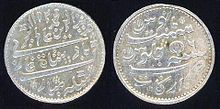
The Indian economy remained as prosperous under the Mughals as it was, because of the creation of a road system and a uniform currency, together with the unification of the country. Manufactured goods and peasant-grown cash crops were sold throughout the world. Key industries included shipbuilding (the Indian shipbuilding industry was as advanced as the European, and Indians sold ships to European firms), textiles, and steel. The Mughals maintained a small fleet, which merely carried pilgrims to Mecca, imported a few Arab horses in Surat. Debal in Sindh was mostly autonomous. The Mughals also maintained various river fleets of Dhows, which transported soldiers over rivers and fought rebels. Among its admirals were Yahya Saleh, Munnawar Khan, and Muhammad Saleh Kamboh. The Mughals also protected the Siddis of Janjira. Its sailors were renowned and often voyaged to China and the East African Swahili Coast, together with some Mughal subjects carrying out private-sector trade.
Cities and towns boomed under the Mughals; however, for the most part, they were military and political centres, not manufacturing or commerce centres. Only those guilds which produced goods for the bureaucracy made goods in the towns; most industry was based in rural areas. The Mughals also built Maktabs in every province under their authority, where youth were taught the Quran and Islamic law such as the Fatawa-e-Alamgiri in their indigenous languages.
The Bengal region was especially prosperous from the time of its takeover by the Mughals in 1590 to the seizure of control by the British East India Company in 1757. In a system where most wealth was hoarded by the elites, wages were low for manual labour. Slavery was limited largely to household servants. However some religious cults proudly asserted a high status for manual labour.
The nobility was a heterogeneous body; while it primarily consisted of Rajput aristocrats and foreigners from Muslim countries, people of all castes and nationalities could gain a title from the emperor. The middle class of openly affluent traders consisted of a few wealthy merchants living in the coastal towns; the bulk of the merchants pretended to be poor to avoid taxation. The bulk of the people were poor. The standard of living of the poor was as low as, or somewhat higher than, the standard of living of the Indian poor under the British Raj; whatever benefits the British brought with canals and modern industry were neutralized by rising population growth, high taxes, and the collapse of traditional industry in the nineteenth century.
Science and technology
Astronomy
While there appears to have been little concern for theoretical astronomy, Mughal astronomers continued to make advances in observational astronomy and produced nearly a hundred Zij treatises. Humayun built a personal observatory near Delhi. The instruments and observational techniques used at the Mughal observatories were mainly derived from the Islamic tradition. In particular, one of the most remarkable astronomical instruments invented in Mughal India is the seamless celestial globe.
Alchemy
Sake Dean Mahomed had learned much of Mughal Alchemy and understood the techniques used to produce various alkali and soaps to produce shampoo. He was also a notable writer who described the Mughal Emperor Shah Alam II and the cities of Allahabad and Delhi in rich detail and also made note of the glories of the Mughal Empire.
Sake Dean Mahomed was appointed as shampooing surgeon to both Kings George IV and William IV.
Technology
Fathullah Shirazi (c. 1582), a Persian polymath and mechanical engineer who worked for Akbar, developed a volley gun.
Akbar was the first to initiate and utilize metal cylinder rockets known as bans particularly against War elephants, during the Battle of Sanbal.
In the year 1657, the Mughal Army utilized rockets during the Siege of Bidar. Prince Aurangzeb's forces discharged rockets and grenades while scaling the walls. Sidi Marjan himself was mortally wounded after a rocket struck his large gunpowder depot and after twenty-seven day's of hard fighting Bidar was captured by the victorious Mughals.
Later onward's the Mysorean rockets were upgraded versions of Mughal rockets utilized during the Siege of Jinji by the progeny of the Nawab of Arcot. Hyder Ali's father Fatah Muhammad the constable at Budikote, commanded a corps consisting of 50 rocketmen (Cushoon) for the Nawab of Arcot. Hyder Ali realized the importance of rockets and introduced advanced versions of metal cylinder rockets. These rockets turned fortunes in favour of the Sultanate of Mysore during the Second Anglo-Mysore War particularly during the Battle of Pollilur.


